| The Tipo 61 'Streamliner' #2451
Many thanks to Le Mans guru Tim Dyke of MPH Models for permission to publish this text |
Times were tough the end of 1957 at the 'Casa del Tridente'. It had won the Grand Prix Constructors' Championship that year, and was in with a chance ol duplicating that success in the world sports car championship. The last race was at Caracas, in Venezuela, on November the third, where the team could have clinched the championship. Four Maseratis (three 450s and one 30OS) written off, compounded by a huge bad debt incurred in Argentina was enough to hammer the final nail into the coffin. The Italian government, sensing that, with more prudent management, a viable company could arise from the ashes, stepped in as receiver. One stipulation made was that the company should not spend any funds on developing new competition cars, nor supporting a racing programme. |
|
After a year of financial strictures the company's health improved, to the extent that the receiver sanctioned some development work on new competition cars, provided that the customers paid for, and raced them, not the factory. The great enthusiasm of Maseratit chief engineer, Ing. Gulio Alfieri, needed no further encouragement. The brief was to find a formula to build a low cost, competitive, two seater racer, raiding the existing parts bin where possible. Alfieri was a great student of the current thinking on chassis design, being very familiar with the works of Chapman and Cooper, among others, and the thought of the quantum leap from the antiquated, bulky ladder frame to a lightweight, multi tube space frame appealed greatly. Although monocoque construction was considered, it was decided against that route, due, apparently, to the lack of contacts and geographic location of the Italian aircraft industry. |
|
The stories surrounding the choice of extremely small diameter tubing (15mm and 1Omm) has given rise to many apocryphal stories, but the reality would appear to suggest that extreme lightness, combined with extreme torsional rigidity were the determining factors. Anyhow, the whole frame weighed in at a mere 66lbs (30kg), and anyone who has driven the Tipo 60/61 will tell you how stiff it is, so it certainly worked! The bodywork was kept very low by canting the engine over at 45 degrees, and overhangs kept minimal, to assist handling. |
The prototype was to have a 2-litre engine, heavily modified from the 200SI model. The bodywork for the first Tipo 60 was entrusted to the Allegreti brothers, who had learnt their trade under the Maestro Fantuzzi. The prototype ran for the first time on the 8th of May 1958, with Bertocchi at the helm. Further testing was entrusted to Stirling Moss, first at Modena and later at the Nürburgring where he lapped under the 2 litre record time. Moss was reported to be delighted with the 'rightness' of the design, light but precise steering, totally neutral handling characteristics and superb brakes being singled out for praise. |
Word had got around the racing world of the potential of the new machine, which rapidly gained the soubriquet of 'Birdcage' due to the multiplicity of parts of the incredibly complicated network of tubes being visible under the screen. |
|||
Omer Orsi, Maserati chairman, authorised the laying down of six chassis, to be sold to privateers. Most of the enquiries emanated from America and of these quite a number expressed an interest in a larger engined version (3 litres) to compete in the foremost class of US racing. In view of this, Orsi agreed to let Alfieri develop a 3 litre engine. Fitting it in to the confined engine bay of the Tipo 60 was his major challenge. Eventually a configuration was worked out at 2896cc, showing little weight penalty, and showing between 300-400lbs saving on the scales, compared to the opposition in the 3 litre class. Although identical to the Tipo 60 in every way except engine size, this model was to be known as the Tipo 61. |
|
Although the official policy was not to enter the car as a factory entry, Orsi was persuaded to market the car by allowing Stirling Moss to enter the 2-litre sports car race at Rouen on 12th July 1959, a decision that proved to be a good one, with Moss giving the model a very convincing win, first time out. |
Lloyd Perry 'Lucky' Casner comes into the plot in September 1959. Something of a smooth talker, he named his team Camoradi (CA-sner MO-tor RA-cinq DI-vision), no doubt part of his pitch to convince the Goodyear tyre company to fund his ambitious 1960 racing plans. He then flew to Italy to test drive the Tipo 60. Impressed, he immediately ordered two Tipo 61 (3-litre) models. Our subject (chassis #2451) was originally the Tipo 60 prototype, driven by Moss at Rouen and by hillclimb specialist Odoardo Govoni to win the 'Pontedecimo-Giovi' event on the 20th September 1959, soundly thrashing the hot favourite Giorgio Scarlatti's Ferrari Dino 196S. |
As Casner needed at least one car to compete at Nassau in December and the opening 1960 round of the sports car championship in the Argentine, and the first batch of six Tipo 61's had already been spoken for, the prototype Tipo 60 was hurriedly modified into a Tipo 61. At the Nassau practice session a trio of very big names tried Casner's car, Gurney, Shelby and Bonnier. Gurney was fastest, a mere half second slower than Moss's Aston DBR2 with an engine 50% greater in capacity. Shelby drove in the race, a burst tyre and various minor problems slowing him until an off-course excursion put him out for good. |
The omens were good for Maserati and Camoradi for the 1960 world sports car championship. Aston Martin, having won in 1959, had pulled out. Ferrari, with their 'Testa Rossa', had been outrun by the 'Birdcage' at Nassau, and Porsche was unlikely to be a contender for overall honours with their small displacement engines. |
The first championship event, at Buenos Aires, saw Gurney/Gregory race away from the field, only to have a shock absorber mounting bolt fail, knock-on effects of which eventually caused it to retire. The second Camoradi, Tipo 61 (chassis #2458) was delivered in time for the non-championship race in Cuba, which Moss won at a canter. Back on the championship scene, Sebring proved a total disaster. Moss/Gurney, way ahead of the field after 8 hours, had a crownwheel and pinion let go on them. Of the five Tipo 61's entered (3 Camoradi + 2 others) four started and four retired, with various maladies. Next came the Targa Florio, in Sicily. In the aftermath of Sebring, Casner sent just one car (our subject 2451) for Targa specialists Maglioli/Vaccarella. Leading by five minutes at the ¾ distance mark, a rock through the tank, and subsequent loss of fuel/power caused Vaccarella to crash. Nürburgring followed the Targa Florio, a mere two weeks later. |
Our subject could not be repaired in time, so Camoradi fielded a two car team, with Moss/Gurney and Gregory/Munaron as drivers, and the notable addition of Piero Taruffi as team manager. For once things held together and in the treacherous weather conditions Moss and Gurney drove a superlative race to win by 3 minutes, with the other team car in fifth place. |
After the Nurburgring triumph, hopes were high for Le Mans, the last event on the championship calendar. #2451 had been repaired after its Targa shunt, and completely re-bodied with the very distinctive long screen, long tail coachwork. (The former being an ingenious attempt to get around the minimum screen height regulations, designed to restrict maximum speeds. By starting the screen at the front axle line and sloping it back to driver's chin level, a very low frontal area was achieved). Two other Camoradi Tipo 61's were entered, with the long tail feature, but without the 'Streamliner's' incredible screen. Driver pairings became a bit of a problem for the race. Moss was dropped for asking too high a fee, Gurney had signed for Briggs Cunningham, and Shelby had a disagreement with Casner over sponsorship. Thus the American pairing of Masten Gregory and Chuck Daigh came to drive the 'Streamliner', with the Italians Scarlatti/Munaron and Casner himself/Jefflords in the other team cars. |
|||
In practice the 'streamliner' was 10 mph faster down the Mulsanne straight than anyone else, at 170 mph. At the start Gregory had problems getting 2451 to fire, and left the line in 24th position, coincidentally carrying the race number 24. In possibly the all time record for catching up, Gregory was in the lead by the time the field had reached Mulsanne corner, having overtaken no less than 18 cars on the straight, believe it or not! After 2 hours, he was an almost incredible 4 minutes in the lead. Gregory came in to hand over to Daigh. After the stop, Daigh hit the starter button, with no result. One hour was lost changing the starter motor, and all the confident optimism of the opening laps evaporated. Shortly afterwards Munaron had his starter motor burn out, too, but out on the circuit where he was left stranded. The third car was brought in, to change its starter motor as a precaution. Casner took this car back into the fray, but came across an errant sandbank at Mulsanne, and jammed the gear linkage. This left the streamliner as the only Camoradi runner, running as fast as ever, and gaining two laps over the leader in the four hours since it retook the stage. Just before midnight it retired, according to Joel Finn, due to Daigh exceeding the rev limit and blowing the motor, whereas other references refer to electrical failure. |
|||
Casner, ever the entrepreneur, had done a deal prior to Le Mans with J. Frank Harrison, a wealthy American entrant, who had agreed that he would take his pick of any of the three Camoradi Tipo 61's after the race. Seeing that the streamliner was by far the quickest of the three, albeit the oldest, this was the one he chose, to be driven by Jim Jeffords (one of the Le Mans team) in domestic events in the States. Le Mans, even though in June, was, curiously, the last race in the world sports car championship that year, so it made good sense for Casner to sell at that point, and for Harrison, as the American season had time to run. |
|||
After a hectic eighteen months racing all over America, the rather tired 2451 was sold to a Mr Don Skosmo, who never raced it. At the end of the sixties it was discovered in the states by Colin Crabbe, that inveterate 'sniffer-out' of historic racing cars. Amazingly enough, although he brought it back to England, and sold it as a rolling chassis to Bob Owen, he did not recognise it as the 'streamliner', even though it still carried its 2451 chassis plate. Bob Owen rebuilt the car, and Brian Joscelyne drove it for him, to win the 1971 'JCB' historic championship (3-litre class), while Bob Owen himself drove his other Birdcage to the 2-litre class championship win. 1972 saw the car pass to 'Hexagon' of Highgate, with Nick Faure performing the enjoyable bit. Thereafter the trail goes cold, until 1980 when it turned up in Peter Kaus's Rosso Bianco collection in Germany. |
|||
| THE TIPO 61 'STREAMLINER' #2451 | ||||
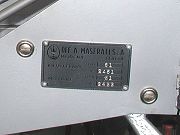 |
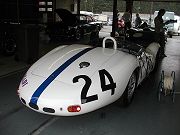 |
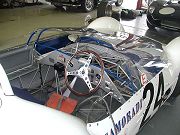 |
||
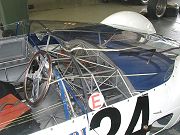 |
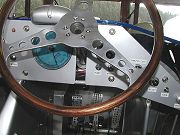 |
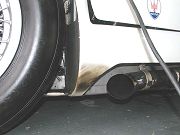 |
||
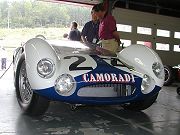 |
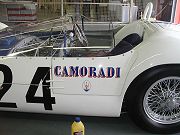 |
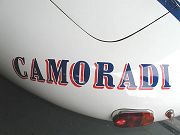 |
||
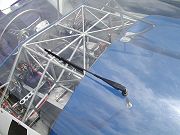 |
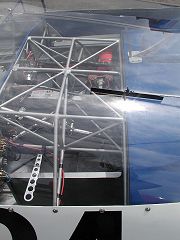 |
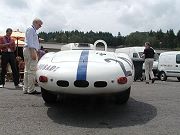 |
||
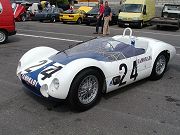 |
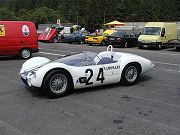 |
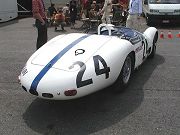 |
||
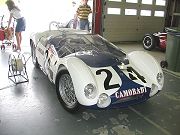 |
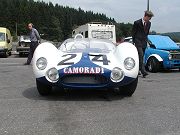 |
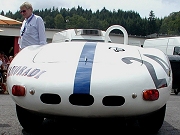 |
||